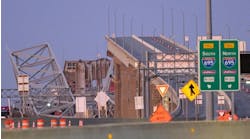By Suze Parker, Contributing Author
In 1918, flour mills lined each sides of the Mississippi River in downtown Minneapolis. In the same year, the iconic Third Avenue Bridge opened, ushering in a new chapter of the city’s growth.
Today, the bridge still delivers freight and remains a central connector that links retail and residential neighborhoods, carrying Trunk Highway 65 across the river in the St. Anthony Falls Historic District.
The span is eligible for placement on the National Registry of Historic Places under Criterion A as a contributing element to the St. Anthony Falls Industrial Historic District and Criterion C for its engineering significance.
A classic example of a cast-in-place concrete arch-type bridge, the Third Avenue Bridge was one of 24 spans selected for long-term preservation under the Minnesota Department of Transportation’s (MnDOT) Statewide Historic Bridge Management Plan. The Third Avenue Bridge was selected for its four character-defining features:
- Cast-in-place Melan Arch System construction, which encases steel trusses in concrete.
- Classic Revival aesthetic treatment on piers, the projecting pedestrian overlooks and ornamental railing added in 1939.
- Reverse S-curve alignment. Created to follow the shortest path over a break in the limestone that supports the bridge footings, the unusual horizontal alignment came to define the bridge as a gateway to downtown Minneapolis; and
- St. Anthony Falls setting. The bridge is a contributing property to the St. Anthony Falls Historic District’s National Register of Historic Places designation.
Rehabilitation of the Third Avenue Bridge, which MnDOT initiated in 2017 to address the structure’s deteriorated conditions and extend its service life for 50 more years, required that the updated structure comply with Section 106 of the National Historic Preservation Act of 1966.
MnDOT selected the HNTB team as engineer of record to study the bridge’s history and inspect, load rate, design and assist in the bridge’s reconstruction under a construction manager/general contractor (CMGC) model. That methodology brought the contractor on board during preliminary design to provide design review, collaboration and pricing with the goal of reducing project risk.
Solving Challenges 40 Years in the Making
Described as a “reserved, orderly and imposing structure” when it opened in 1918, the Third Avenue Bridge can still be described this way, with its two steel beam spans on the south, five open-spandrel column arch rib spans, two open-spandrel wall barrel arch spans and two concrete beam spans on the north. It crosses the Upper St. Anthony Falls lock and dam in downtown Minneapolis and a smaller, lower falls.
The 40 years since the last rehabilitation took a toll on the bridge. That 1980 rehabilitation replaced all original deck, spandrel cap beam and rail pilaster elements, erasing much of the bridge’s historical architecture. Only the 1939 ornamental railing remained.
Some spandrel columns exhibited severe shear cracking at their bases. Pier bases were damaged from years of water draining from the deck above via ill-configured drain outlets, and the top of Pier 8 had moved about an inch, severely cracking the large pier wall.
Extensions added to the historic retaining walls at the northern abutment in 1980 to raise the grade were leaning outward. Historic concrete was extensively deteriorated throughout the bridge.
“The concrete mixes used previously on the bridge were different than those we use today,” said MnDOT Project Engineer Christian Hoberg. “That created design and construction challenges and demanded that we understand the structure’s capacity so that when we removed and replaced millions of pounds of concrete, we sequenced that work in a way that didn’t introduce new damage to the bridge.”
The first phase of the contract aimed to identify the scope of work needed. To achieve that goal, HNTB developed a full, as-built and as-inspected load rating to understand the bridge’s capacity. WJE, a subcontractor to HNTB, completed full bridge inspection and testing.
With that information, preliminary design was finished in phase two, resulting in taking the bridge down to its arch ribs and building it back up. Final design, which included replacing the spandrel columns, spandrel cap beams, deck and railing pilasters, refurbishing the 1939 aluminum railing, repairing the concrete surface, cost estimating and staging, was completed in phase three.
“Geometry was an especially complicated part of the design,” said Daniel Enser, a senior project manager at HNTB. “The spandrels were straight, but we were working with a curved deck on top. The ends of the cap beams all varied on curved Spans 1, 5, 6 and 7. When the bridge was built, the spandrel columns and cap beams were the same width, but the 1980 rehabilitation widened and squared off the cap beams. To meet the project’s historic requirements, the cap beam width had to match the column width. The geometry to make that happen had to be as perfect as possible.”
By placing a lidar scanner on a drone, a boat and a car, the design team was able to understand the size of the elements and develop a real-world bridge model that was accurate within a couple of millimeters. That process allowed the cap beams to be restored to their original widths and pilaster to match the 1939 ornamental railing lengths.
Piers 3 and 4 were a concern. They are in the lower pool of St. Anthony Falls, an inherently difficult area to access. The piers needed repairs down to the footing, requiring a dewatered condition to remove 12 inches of existing concrete, install new dowels and form and pour the repairs. To access the piers and make repairs, the project team took advantage of unusual, low-flow river conditions in fall 2020, allowing giant sandbags, combined with clean fill, to redirect the river.
A leading cause of deterioration on the bridge was its large number of joints, which allowed chloride-laden drainage to reach the lower concrete elements. Spandrel columns were lightly reinforced and cracked from joints that restrained the bridge from thermal movement.
To confront this challenge and address thermal forces, HNTB designed a replacement deck, cap beams and spandrel columns that reduced the number of expansion joints from 42 to 15 so the bridge has fewer joints for drainage to ingress.
The team rearticulated the deck by separating it from the cap beams and installing elastomeric bearing pads to provide improved deck movement. This necessitated more headroom between the deck and an existing 36-inch water main running below the bridge deck, requiring the two north existing concrete beam spans to be raised.
Protecting the Arches
When rehabilitation required removal and replacement of 76 million pounds of concrete bridge deck, cap beams and spandrel columns, the limited river access precluded deployment of a marine fleet with large equipment that could have operated from the waterway to move the concrete on and off the bridge. The team worked from the bridge itself — but that presented a second challenge.
“Taking off a piece of bridge deck and placing it back down elsewhere on the bridge can create asymmetric loading,” Hoberg said. “Arches are sensitive to unbalanced loading. We risked bending them and inducing cracking if the work wasn’t handled properly.”
To maneuver in the constrained space and avoid damaging the arches, the team used tower cranes, which allowed concrete removal and replacement to be sequenced, ensuring the arches were symmetrically loaded throughout the process.
Although a full closure was necessary for a period, the project team kept the bridge partially open for as long as possible, maintaining one open lane in each direction for six months. An additional dynamic, dedicated transit lane that allowed buses to carry passengers into downtown Minneapolis in the mornings was reversed in the evenings to permit bus passengers to exit downtown.
Returning to Historic Architecture
The rehabilitated Third Avenue Bridge includes changes that meet current safety and engineering criteria while preserving its important features, structural integrity and historic significance.
Original design details were reinstated on the cap beams. Durable, updated lighting speaks to the past and respects the property’s historical aspects. The ornamental concrete balustrade railing placed on the bridge in 1939 and restored during the recent rehabilitation was enhanced to narrow the gaps between the rails. This change adheres to today’s safety standards while fitting aesthetically with the railing’s overall nature.
Collaboration with local and state agencies, historical experts, the contractor, a peer reviewer and teaming partners was key to delivering a revitalized Third Avenue Bridge, which opened Oct. 28, 2023.
“We worked closely with MnDOT’s Cultural Resources Unit as the liaison between the design team and the State Historic Preservation Office,” said Daniel Enser, HNTB project manager. “The CRU had input on everything from how the Third Avenue Bridge should be repaired and how much original material would be removed to how the bridge should look, down to the concrete repair board forming and coating colors. This was a rewarding working relationship that ensured the finished product met the state’s historic requirements.”
Hoberg added that the rehabilitated Third Avenue Bridge is an example of MnDOT’s stewardship of the state’s historic resources.
“The team has worked to understand the roadway needs, made investments to support all users and ensured there was no change in the traffic loads the rehabilitated bridge could carry,” Hoberg said. “Without creating any adverse impact to the span’s historic designation, the Third Avenue Bridge will continue to serve downtown Minneapolis as it has for the last 100 years.” RB
Suze Parker is a public relations consultant and writer who frequently writes about roads, bridges and other infrastructure projects.



